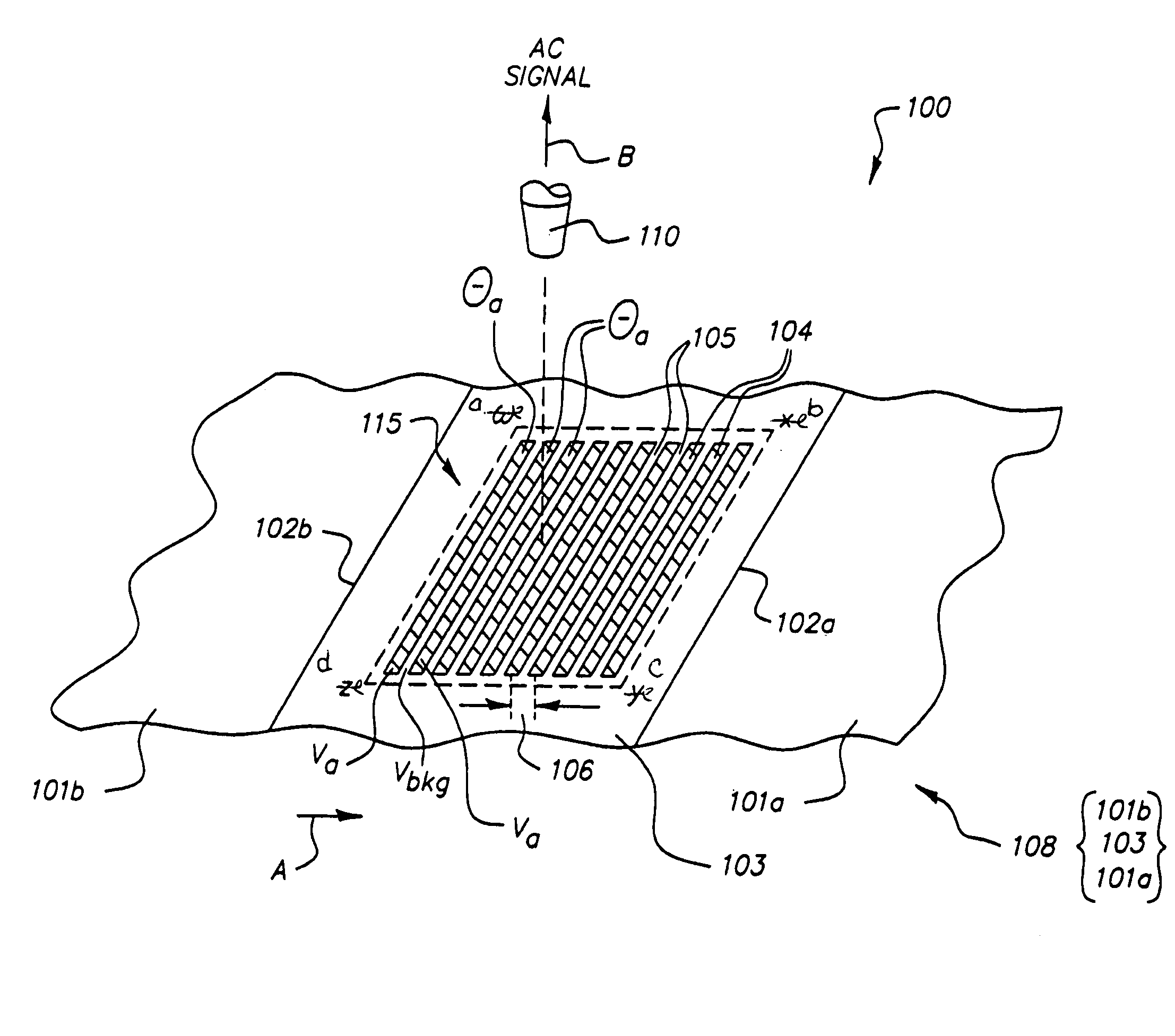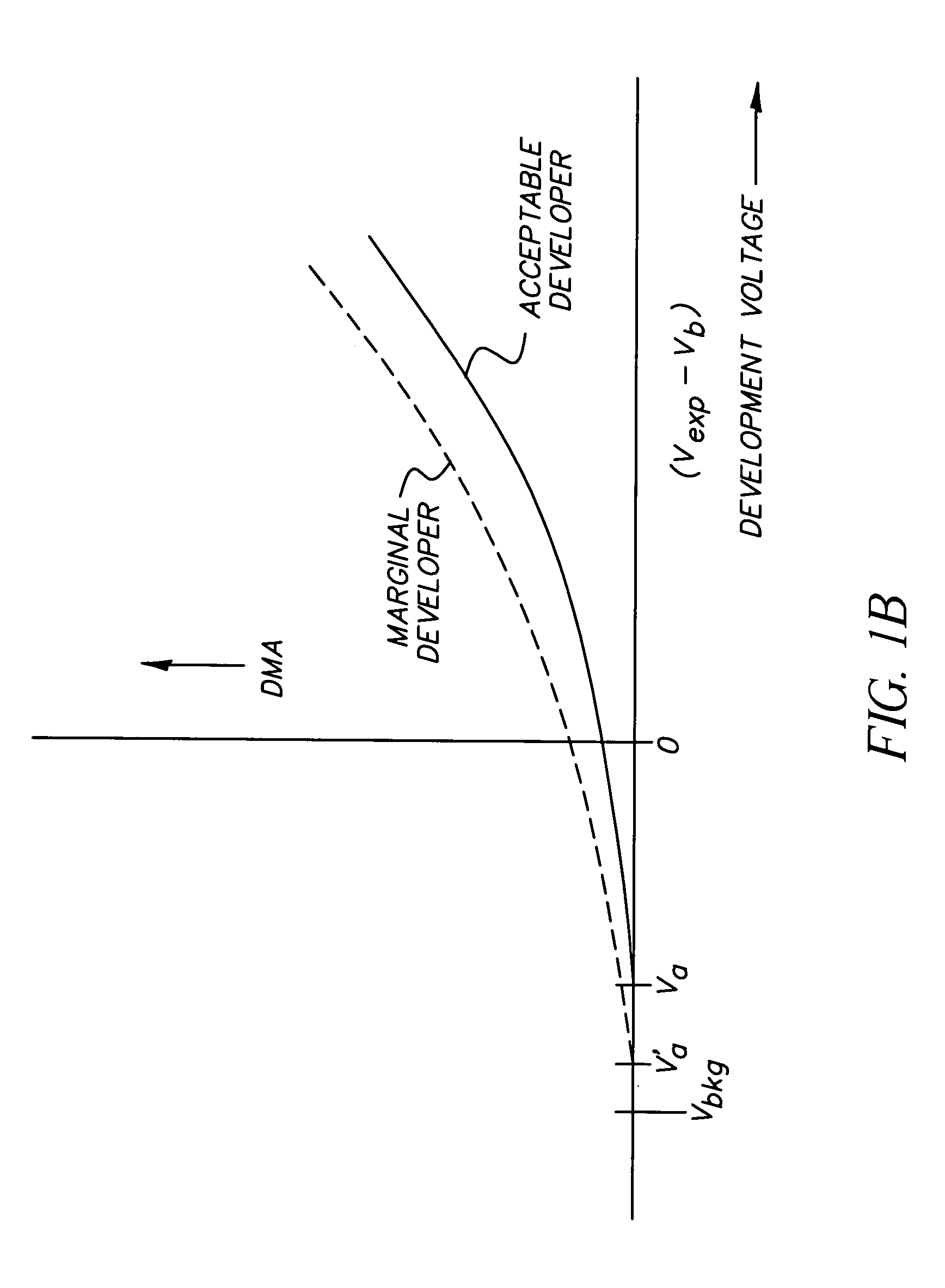Detection of background toner particles
- Summary
- Abstract
- Description
- Claims
- Application Information
AI Technical Summary
Benefits of technology
Problems solved by technology
Method used
Image
Examples
embodiment 100
[0056]Returning to embodiment 100, strips 104 may, depending on developer age, include toner particles representative of toner particles in a background portion of a toner image in an image frame 101a,b. The spaces 105 are substantially free of toner particles. It is preferred that strips 104 and spaces 105 all have a width of approximately 0.5 mm, such that the width of a distance 106 between each pair of like strips 104 is about 1 mm. However, any suitable widths for strips 104 and spaces 105 may be employed.
[0057]Referring again to the exemplary FIGS. 1A, 1B (as well as FIG. 2), spaces 105 are substantially free of toner (e.g., originated on a photoconductor by a photoexposure producing a development voltage preferably of magnitude less than or equal to the background development voltage, for example Vbkg). The strips 104 have a toner coverage θa, with θa originating in relation to a threshold development voltage, e.g., the threshold development voltage Va in FIG. 1A. As explaine...
embodiment 200
[0069]In another preferred embodiment (not illustrated) synchronous detection is used in a manner analogous to the manner of embodiment 200, except that the reference AC signal is not obtained from a parallel patch but is derived from other sources permitting good synchronization with the strips in the control patch area. These other sources, which are preferably of non-electrostatographic origin, include encoder signals accurately monitoring the position of the toner-image-bearing member, perforations located along an edge of a toner-image-bearing member in the form of a web or belt, or image registration marks located on the toner-image-bearing member. Thus when the control AC signal has a certain frequency, the reference AC signal preferably has a calibrated amplitude and a reference frequency suitable for use with the control AC signal in a synchronous detection circuit, so that the synchronous detection circuit produces a DC output having an amplitude proportional to the low co...
embodiment 300
[0070]In a preferred embodiment 300 illustrated in FIG. 4, a low coverage of toner particles relating to a background area of a toner image in an image frame is included in a composite toner patch image 315 located on a toner-image-bearing member 325 (member 325 partially indicated, image frame not indicated in FIG. 4). Preferably, the toner-image-bearing member 325 is a photoconductive imaging member. The composite toner patch image 315, defined by the parallelogram, efgh, is located in a non-image area which is preferably an interframe area, the composite toner patch image 315 including a plurality of equally spaced toned strips inclusive of strips 304 and 306. Strips 304 and 306 are mutually parallel and perpendicular to the direction of movement of toner-image-bearing member 325, as indicated by the arrow, A″.
[0071]The toned strips include control toned strips 304 and reference-toned strips 306, the control toned strips 304 having a lower coverage of toner than the reference-ton...
PUM
 Login to View More
Login to View More Abstract
Description
Claims
Application Information
 Login to View More
Login to View More - R&D
- Intellectual Property
- Life Sciences
- Materials
- Tech Scout
- Unparalleled Data Quality
- Higher Quality Content
- 60% Fewer Hallucinations
Browse by: Latest US Patents, China's latest patents, Technical Efficacy Thesaurus, Application Domain, Technology Topic, Popular Technical Reports.
© 2025 PatSnap. All rights reserved.Legal|Privacy policy|Modern Slavery Act Transparency Statement|Sitemap|About US| Contact US: help@patsnap.com



